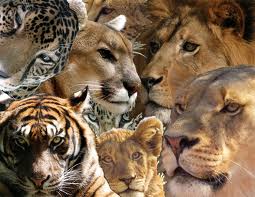All around the world there are of big cats that need our help?

The term big cat – which is not a biological classification – is used informally to distinguish the larger felid species from smaller ones. One definition of "big cat" includes the four members of the genus Panthera: the tiger, lion, jaguar, and leopard. Members of this genus are the only cats able to roar. A more expansive definition of "big cat" also includes the cheetah, snow leopard, and cougar.
Despite enormous differences in size, the various species of cat are quite similar in both structure and behavior, with the exception of the cheetah, which is significantly different from any of the big or small cats. All cats are carnivores and efficient predators, in fact they are apex predators. Their range includes the Americas, Africa, Asia, and Europe.
Roaring
The ability to roar comes from an elongated and specially adapted larynx and hyoid apparatus. (However, the snow leopard cannot roar, despite having hyoid morphology similar to roaring cats.) When air passes through the larynx on the way from the lungs, the cartilage walls of the larynx vibrate, producing sound. The lion's larynx is longest, giving it the most robust roar.
Threats
The principal threats to big cats varies upon geographical location, but primarily are habitat destruction and poaching. In Africa many big cats are persecuted by pastoralists or government 'problem animal control' officers. Certain protected areas exist that shelter large and exceptionally visible populations of lions, hyaenas, leopards and cheetahs, such as Botswana’s Chobe, Kenya’s Masai Mara and Tanzania’s Serengeti. It is rather outside these conservation areas where persecution poses the dominant threat to large carnivores.
In the United States, 19 states have banned ownership of big cats and other dangerous exotic animals as pets, and the Captive Wildlife Safety Act bans the interstate sale and transportation of these animals. Nevertheless, there are still an estimated 15,000 big cats kept captive in the United States, and only a small percentage of them are in accredited zoos. The remainder are in private homes and nonaccredited roadside zoos.
Evolution
A 2010 study published in Molecular Phylogenetics and Evolution has given insight into the exact evolutionary relationships of the big cats. The study reveals that the Snow leopard and the tiger are sister species, while the lion, leopard, and jaguar are more closely related to each other. The tiger and snow leopard diverged from the ancestral big cats approximately 3.9 Ma. The tiger then evolved into a unique species towards the end of the Pliocene epoch, approximately 3.2 Ma. The ancestor of the lion, leopard, and jaguar split from other big cats from 4.3-3.8 Ma. Between 3.6-2.5 Ma the jaguar diverged from the ancestor of lions and leopards. Lions and leopards split from one another approximately 3.1-1.95 Ma